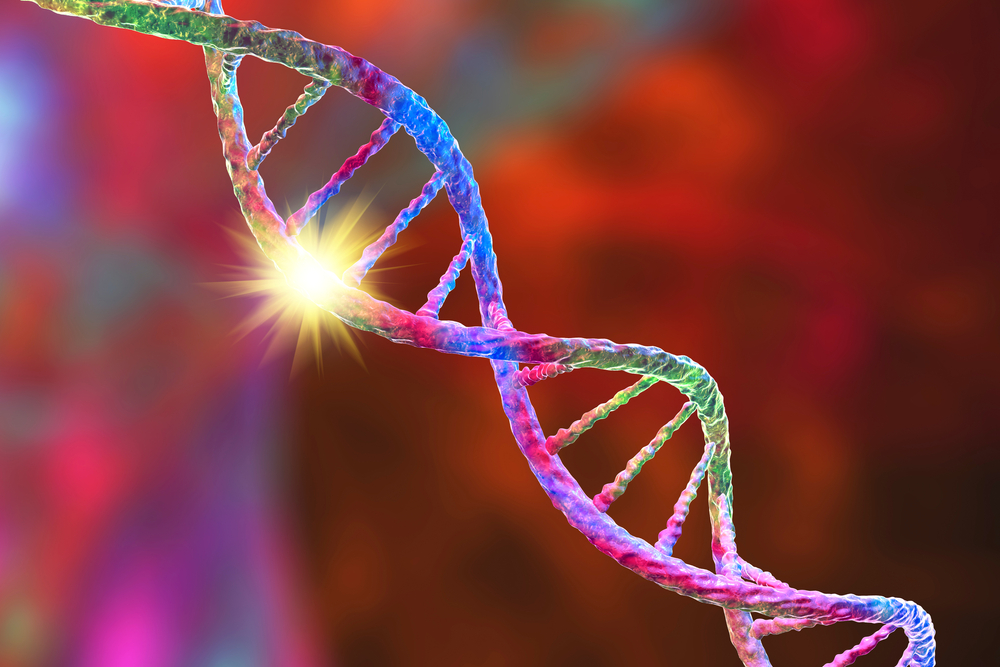Life, in all its complexity and diversity, is written in a single language—the language of DNA. This molecule, made up of sequences of four chemical bases, forms the genetic code that dictates how every living organism functions, grows, and reproduces. DNA’s instructions are astonishingly precise, but they are not infallible. Sometimes, mistakes occur when DNA is copied, repaired, or expressed—mistakes known as genetic mutations.
These mutations are more than mere biological accidents. They are both the source of genetic disease and the driving force behind evolution. Through mutations, species adapt to changing environments, new traits emerge, and life continues to diversify. Yet, mutations can also cause devastating effects, leading to cancer, inherited disorders, or cell malfunction. Understanding genetic mutations means understanding the balance between error and innovation that defines life itself.
The Structure of DNA and the Origins of Mutation
To comprehend how mutations arise, it is essential to understand the structure of DNA. DNA (deoxyribonucleic acid) consists of two complementary strands twisted into a double helix. Each strand is built from repeating units called nucleotides, composed of a sugar, a phosphate group, and a nitrogenous base. The four bases—adenine (A), thymine (T), cytosine (C), and guanine (G)—pair specifically (A with T, and C with G), forming the rungs of the helical ladder.
When cells divide, their DNA must be precisely replicated to ensure that each daughter cell inherits an identical genetic code. Enzymes like DNA polymerase oversee this replication process, proofreading and correcting most errors as they go. Despite this, occasional mistakes slip through. A base may be inserted, deleted, or substituted incorrectly. These small changes can alter the sequence of nucleotides, potentially changing the meaning of the genetic message.
Radiation, chemical exposure, and biological agents can also damage DNA. Ultraviolet light can cause thymine bases to bond incorrectly, forming “thymine dimers.” Chemicals like those found in tobacco smoke can bind to DNA and distort its structure. Even normal metabolic processes generate reactive molecules that can attack DNA bases. The cell has sophisticated repair systems to correct such damage, but when repair fails, mutations remain.
The Nature of Genetic Mutations
A mutation is any change in the DNA sequence that differs from the original genetic code. These changes can range from a single base alteration to large-scale rearrangements of entire chromosomes. The consequences of a mutation depend on where in the genome it occurs and what type of change it introduces.
Some mutations are silent—they alter the DNA sequence without changing the protein product because multiple codons can code for the same amino acid. Others are missense mutations, which change one amino acid in a protein, potentially altering its structure or function. More serious are nonsense mutations, which prematurely stop protein synthesis, producing incomplete and usually nonfunctional proteins.
Insertions or deletions can have dramatic effects if they occur within a gene. Because the genetic code is read in triplets of bases, the addition or removal of nucleotides can shift the reading frame—a phenomenon called a frameshift mutation. This change alters every codon downstream of the mutation, usually destroying the protein’s functionality.
Large-scale mutations can involve duplications, inversions, or translocations of chromosome segments. Such events may disrupt gene regulation, create hybrid genes, or lead to abnormal cell behavior. For example, the translocation between chromosomes 9 and 22 produces the “Philadelphia chromosome,” which generates an abnormal fusion protein that drives chronic myelogenous leukemia (CML).
How Mutations Arise Spontaneously
Even in the absence of external influences, DNA is a dynamic molecule prone to spontaneous alterations. One common spontaneous mutation involves tautomeric shifts, in which a base temporarily changes its chemical structure, leading to incorrect pairing during replication. For instance, adenine may pair with cytosine instead of thymine, introducing a substitution.
Another frequent cause of spontaneous mutation is deamination, the loss of an amino group from a base. Cytosine can deaminate into uracil, which pairs with adenine instead of guanine, leading to a C-G to T-A substitution after replication. Similarly, depurination—the loss of a purine base (adenine or guanine)—creates a gap in the DNA sequence that can cause incorrect base insertion.
Replication errors also contribute to spontaneous mutations. DNA polymerases, despite their proofreading ability, make occasional mistakes—about one in every billion bases replicated. Given the enormous size of the human genome, that means each cell division can introduce several mutations. Fortunately, most occur in noncoding regions or have negligible effects.
Mutagens and Induced Mutations
While some mutations occur spontaneously, others are induced by environmental agents known as mutagens. Mutagens can be physical, chemical, or biological in nature, and they increase the frequency of DNA errors.
Radiation is one of the most potent mutagenic forces. Ultraviolet (UV) light from the sun causes adjacent thymine bases to bond together, forming dimers that distort the DNA helix and block replication. If not repaired, these distortions can lead to mutations that accumulate over time and cause skin cancers such as melanoma. Ionizing radiation—such as X-rays, gamma rays, or cosmic rays—can break DNA strands or produce reactive ions that chemically damage bases. Such mutations are often severe and sometimes lethal.
Chemical mutagens act by interacting directly with the DNA molecule. Base analogs mimic normal bases but pair incorrectly during replication, introducing point mutations. Alkylating agents add chemical groups to DNA bases, altering their pairing properties. Intercalating agents like ethidium bromide insert themselves between DNA bases, causing insertions or deletions when the DNA replicates.
Certain biological agents also act as mutagens. Some viruses integrate their genetic material into host DNA, disrupting genes or regulatory regions. The human papillomavirus (HPV), for example, can insert oncogenes into host genomes, triggering uncontrolled cell growth and cancer.
DNA Repair: The Defense Against Mutation
To counteract these threats, cells have evolved multiple repair systems that maintain the stability of the genome. Without them, the accumulation of mutations would quickly lead to cell death or disease.
One key repair mechanism is mismatch repair, which detects and corrects errors that escape DNA polymerase proofreading. Specialized enzymes recognize the distorted DNA structure at a mismatched base pair, remove the incorrect segment, and replace it with the correct sequence. Defects in mismatch repair genes are linked to hereditary cancers, such as Lynch syndrome.
Base excision repair fixes small, non-helix-distorting lesions, like deaminated or oxidized bases. Enzymes called glycosylases recognize and remove the damaged base, after which other enzymes fill in the gap with the correct nucleotide. Nucleotide excision repair (NER), on the other hand, targets bulky distortions such as thymine dimers. The damaged segment is cut out and replaced through coordinated enzymatic action.
When DNA damage is extensive—such as breaks in both strands—cells use homologous recombination or non-homologous end joining to reconnect the broken ends. Homologous recombination uses an undamaged DNA copy as a template, ensuring accurate repair. Non-homologous end joining is faster but more error-prone, as it directly ligates the broken ends without a template, often leading to insertions or deletions.
Despite these sophisticated systems, no repair mechanism is perfect. A small fraction of errors always remain, becoming permanent mutations passed on during cell division or inheritance.
The Role of Mutations in Evolution
While mutations can be harmful, they are also the raw material of evolution. Without mutations, there would be no genetic variation for natural selection to act upon, and life would stagnate. Mutations introduce diversity into populations, providing new traits that may enhance survival in changing environments.
For example, a single point mutation in the hemoglobin gene produces the altered hemoglobin found in sickle-cell anemia. Although this mutation causes disease in individuals with two copies, those with one copy (heterozygotes) are more resistant to malaria. In malaria-endemic regions, this advantage allows the mutation to persist in the population.
Similarly, mutations in bacteria can confer resistance to antibiotics, enabling them to survive and multiply despite drug treatment. This demonstrates evolution in real time, driven by selective pressures acting on random genetic changes.
Over millions of years, beneficial mutations accumulate, leading to the development of new species and complex biological systems. Every feature of life—from the ability of birds to fly to the human capacity for language—ultimately traces back to ancient genetic mutations preserved through evolutionary success.
Deleterious and Neutral Mutations
Although mutations are the foundation of evolution, most are neutral or deleterious rather than beneficial. Neutral mutations occur in noncoding regions of DNA or change a protein in ways that neither help nor harm the organism. Over time, these mutations accumulate as “molecular clocks,” allowing scientists to estimate evolutionary relationships between species.
Deleterious mutations, in contrast, disrupt essential genes or cellular processes. Many inherited genetic disorders arise from such harmful mutations. Cystic fibrosis, for example, results from mutations in the CFTR gene, which encodes a protein that regulates chloride transport in cells. Mutations in this gene cause thick mucus buildup in the lungs and digestive tract. Huntington’s disease is caused by a mutation that expands a repeated DNA sequence, leading to progressive neurodegeneration.
Some mutations have delayed or context-dependent effects. A mutation that predisposes individuals to cancer, for instance, may remain harmless until additional genetic or environmental factors trigger uncontrolled cell growth.
Somatic and Germline Mutations
Not all mutations are passed to future generations. The distinction between somatic and germline mutations is crucial. Somatic mutations occur in non-reproductive cells and affect only the individual in which they arise. They are common in cancers, where accumulated mutations drive the transformation of normal cells into malignant ones.
Germline mutations, by contrast, occur in reproductive cells—sperm or eggs—and are inherited by offspring. These mutations become part of the organism’s genome and can be transmitted to future generations. Inherited genetic diseases and evolutionary adaptations alike depend on germline mutations.
In multicellular organisms, most mutations are somatic, but only germline mutations contribute to long-term evolutionary change. This distinction underscores the dual nature of mutation as both a personal biological risk and a species-wide creative force.
Mutations and Cancer
Cancer provides one of the clearest examples of how mutations can disrupt cellular control. Normal cells grow and divide in a tightly regulated manner, governed by genes that either promote division (proto-oncogenes) or suppress it (tumor suppressor genes). When mutations activate proto-oncogenes into oncogenes or disable tumor suppressor genes, the balance between growth and inhibition is lost, leading to uncontrolled proliferation.
For example, mutations in the TP53 gene, which encodes the tumor suppressor protein p53, are found in more than half of human cancers. p53 normally halts the cell cycle when DNA damage occurs, allowing for repair or initiating cell death if the damage is irreparable. When p53 is mutated, cells can continue dividing with damaged DNA, accumulating additional mutations that drive tumor progression.
Environmental factors such as radiation, tobacco smoke, and viral infections increase mutation rates in critical genes, raising cancer risk. Understanding these mechanisms has led to advances in cancer prevention, diagnosis, and treatment, including targeted therapies that correct or exploit specific genetic changes.
Genetic Mutations in Human Disease
Beyond cancer, mutations underlie a wide spectrum of genetic disorders. Some are monogenic, caused by mutations in a single gene, while others are polygenic, involving complex interactions between multiple genes and environmental factors.
Monogenic disorders include sickle-cell anemia, cystic fibrosis, Tay-Sachs disease, and phenylketonuria. Each arises from a specific mutation that alters a crucial protein. For instance, in phenylketonuria, a mutation in the PAH gene disrupts the breakdown of phenylalanine, leading to toxic accumulation that impairs brain development if untreated.
Polygenic disorders, such as diabetes, heart disease, and schizophrenia, result from combinations of small mutations across many genes, each contributing incrementally to disease risk. Environmental influences like diet, stress, and lifestyle further modulate these risks, showing that genes are only part of the story.
Beneficial Mutations and Human Adaptation
Although many mutations are harmful, some confer advantages that have shaped human evolution. One well-known example is the mutation in the CCR5 gene that provides resistance to HIV infection. Individuals with two copies of this mutated gene lack the receptor that HIV uses to enter immune cells, rendering them largely immune to infection.
Another example is lactase persistence—the ability to digest lactose, the sugar in milk, into adulthood. This trait arose from mutations in regulatory regions near the lactase gene (LCT) and became advantageous in populations that domesticated dairy animals, providing a nutritional edge.
Such beneficial mutations illustrate how genetic variation enables human populations to adapt to environmental and cultural changes over time.
Detecting and Studying Mutations
Modern molecular biology has revolutionized our ability to detect and analyze mutations. Techniques such as polymerase chain reaction (PCR), DNA sequencing, and genome-wide association studies allow scientists to identify even single-base changes across entire genomes.
Next-generation sequencing technologies can rapidly read billions of DNA fragments, revealing the complete genetic makeup of individuals or populations. These methods have enabled the discovery of genetic risk factors for diseases, the reconstruction of evolutionary histories, and the development of personalized medicine tailored to an individual’s genetic profile.
Bioinformatics tools further analyze massive datasets, identifying patterns and correlations between mutations and traits. The Human Genome Project, completed in 2003, laid the groundwork for this revolution by mapping all human genes. Today, whole-genome sequencing is increasingly used in research, clinical diagnosis, and ancestry analysis.
Mutation and Genetic Engineering
With advances in genetic technology, scientists can now not only detect mutations but also create or correct them deliberately. CRISPR-Cas9, a powerful gene-editing tool, allows precise modification of DNA sequences. By guiding the Cas9 enzyme to a specific location in the genome, researchers can cut and replace faulty DNA, potentially curing genetic diseases at their source.
Gene therapy uses similar principles to introduce functional copies of genes into patients’ cells. Trials have already shown success in treating conditions like spinal muscular atrophy and inherited blindness. However, ethical and safety challenges remain, particularly when it comes to editing germline cells, as changes would be passed to future generations.
The ability to manipulate mutations has immense promise but also profound implications. It blurs the line between natural evolution and human-directed genetic change, raising questions about responsibility, equity, and the definition of what it means to be human.
Mutations, Diversity, and the Future of Life
Mutations are not merely flaws in the genetic code; they are the creative engine of biological diversity. Every living species, from bacteria to humans, carries the marks of countless mutations accumulated over billions of years. Most of these changes were neutral or harmful, but a small fraction produced new abilities and forms of life.
In an age of climate change and ecological disruption, understanding mutation is more important than ever. The ability of species to adapt to changing environments depends on the genetic variation generated by mutations. In agriculture, controlled mutation and genetic modification are used to develop crops resistant to pests, diseases, and drought. In medicine, studying mutations reveals the origins of pathogens and helps design better vaccines and treatments.
At the same time, human activities—radiation, pollution, and genetic manipulation—introduce new sources of mutation that could have unforeseen consequences. The challenge for future generations will be to harness the power of mutation responsibly, balancing innovation with preservation.
Conclusion
Genetic mutations are the paradox at the heart of life. They are both errors and innovations, destructive forces and creative sparks. Every cell division risks a mistake, yet without those mistakes, life would never change or evolve. Mutations cause diseases, shape species, and write the story of evolution itself.
From the smallest molecular error to the emergence of new traits and species, mutations are the threads that weave together the past, present, and future of biology. They remind us that perfection is not the engine of life—imperfection is. Each mutation, whether harmful or beneficial, is a tiny experiment conducted by nature, testing the boundaries of possibility.
Understanding genetic mutations allows us to read, interpret, and even rewrite the genetic code that defines us. It offers insight into the origins of disease, the mechanisms of evolution, and the essence of what it means to be alive. Through the lens of mutation, we see that life’s greatest strength lies in its capacity to change—and in every mistake, there is the potential for something profoundly new.






